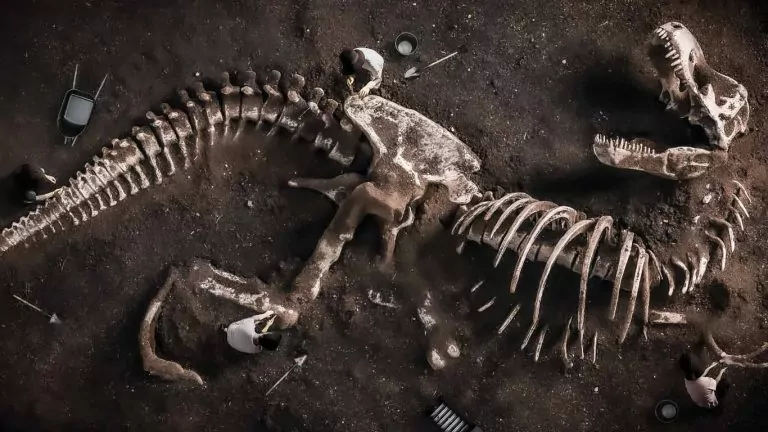If Lenin’s body can’t last, how could dinosaur tissue have lasted millions of years?
*****
In a Russian laboratory, a team of highly trained Russian scientists is leaning over a dead body. The body is that of a man who has been dead for over 90 years, and these scientists are being paid $200,000 a year to keep this man looking alive. They are good at what they do, such that some people consider this body to be the best preserved corpse in the world.
These are the earthly remains of the infamous Vladimir Lenin, socialist revolutionary and founder of the Soviet Union. It is estimated that he killed 3.7 million of his own people during his bloody reign of terror. He was an avowed atheist and declared that “there is nothing more abominable than religion,” and “all worship of a divinity is a necrophilia.” He was responsible for the mass killing of thousands of Christian in Russia.
When Lenin died in January of 1924, the first embalming efforts began at a Moscow location that would later be termed the “Lenin lab.” It might seem like it should be an easy task to preserve a body for a long time, but it is actually very difficult. There were times when up to 200 scientists were employed at the Lenin lab, researching and testing the best ways to preserve Lenin’s body. They have partially succeeded. If you go to see the body of Lenin today, lying in his glass sarcophagus in Red Square you might think he looks in fairly good condition.
The reality is that it has been a huge task to keep him looking like that. The sarcophagus is cooled to 61 degrees, with the humidity between 80 and 90 percent. Underneath his clothing there is a double-layered rubber suit that keep a thin layer of embalming fluid continually covering his body. The body gets re-embalmed once every other year, using a process that involves submerging the body in baths of glycerol solution, formaldehyde, potassium acetate, alcohol, hydrogen peroxide, acetic acid solution and acetic sodium. Each session takes about 45 days.
After the re-embalming Lenin is carted back to his sarcophagus, but each week he is visited by scientists who carefully examine his skin using precision, scientific instruments to detect any change in moisture, color and contour. Dehydration and time are the main enemies. If any fungus stains or mold spots are detected on Lenin’s face they are carefully treated with a mild bleach solution. A doctor who worked on the body from 1934 to 1952 said that with current preservation techniques, the body could last “many decades, even for 100 years.”
It is now getting close to 100 years, but despite the best efforts of hundreds of scientists and over 90 years of research Lenin’s body is still deteriorating; the best of modern science has not been able to stop the downward march to dust. Artificial skin has been created to replace what is deteriorating, and his nose, face, and other parts of his body have been resculpted to restore their appearance. A moldable material made of paraffin, glycerin and carotene has been used to replace much of the skin fat to maintain the original shape of the body. It has been estimated that only 23% of Lenin’s original body tissue still remains. The rest has been replaced by artificial materials. So the famous body of Lenin is becoming more and more of a “wax” sculpture and less and less of a real body.
Another well-preserved body
Let us now leave Russia and visit another location, this time on the other side of the world. Once again a team of scientists is bending over the remains of a body. This time they are not in a high-tech laboratory. They have just finished removing these remains from the dirt. Once again it is a very old body, but this time all they have is the skeleton. It’s the bones of a T-rex dinosaur, and a paleontologist named Mary Schweitzer is about to take one of its bones back to her laboratory for careful study. It’s there that she places the bone in a solution of EDTA, to dissolve the bone matrix.
To the astonishment of the scientific community, she discovered that there was still soft tissue inside – blood vessels, red blood cells, etc. At first some of the other scientists ridiculed her because they said, “These fossils are millions of years old and we know that biological material doesn’t last that long!” But she finally proved that it was the soft tissues of the dinosaur itself, and the majority of the scientific community accepted her discovery.
As time went by more and more fossils from all over the world were tested and found to still contain soft tissues. If you saw some of the microscope pictures you might easily think you were looking at a piece of meat from the grocery store. The level of preservation is quite amazing! Even the microscopic structures of veins, red blood cells, osteocytes, and nerves have been preserved!
Young earth or old flesh?
Now the scientists had a problem. Most of them believed the dinosaurs had died out 65 million years ago, and previous experiments had shown that soft tissues should not last for millions of years. But they weren’t willing to let go of their belief that evolution happened over millions of years, so they started scrambling for answers to explain why the dinosaur bones still had soft tissue in them.
Scientists who believed that the fossils formed in a worldwide flood about 4,400 years ago, like the Bible describes, didn’t have a problem with this discovery. Like so many other discoveries in recent science, it matched very well with their belief that the earth is only about 6,000 years and the fossils formed during the flood. This was exciting news for them, but not for the evolutionary scientists!
Mary Schweitzer next did an experiment by soaking ostrich blood vessels in concentrated blood plasma for two years to see what would happen. She reported that after two years the blood vessels were still recognizable. She suspected that the iron in the blood acted somewhat like a preservative. So she put forth the theory that maybe the soft tissue in the dinosaur bones had been preserved for millions of years by iron in the blood of the dinosaurs. She compared it to the action of formaldehyde, except not as strong. The scientists who believed in Darwinian evolution immediately grabbed onto this explanation as the answer to their dilemma. They said that this experiment must explain how dinosaur soft tissue could last for millions of years.
But does it really? Many of the bones Mary Schweitzer tested are dated by evolutionists at 145,000,000 to 199,000,000 years old. Can a 2-year experiment in a climate controlled laboratory be extrapolated to explain 145,000,000 years of preservation under harsh environmental conditions? Animals die all the time. We’ve all seen them dead beside the road. Does the iron in their blood act as a preservative to keep their tissues from decaying?
Ninety years of research and the combined knowledge of up to 200 scientists has not been able to stop the decay of Lenin’s body. They are using the most advanced preservation techniques and the best embalming chemicals, including formaldehyde, but that is still not enough to stop the slow, but steady decline into dust. “For dust thou art, and unto dust shalt thou return” (Gen. 3:19). It appears that iron molecules do have some preservative qualities that act in a similar way to formaldehyde, except that they are weaker than formaldehyde. And we can see that even formaldehyde itself, combined with other strong chemicals cannot preserve tissue indefinitely. A large portion of Lenin’s body is already gone after only ninety years. It is even surprising to find that fragments of soft tissue have been preserved in dinosaur bones for over 4,000 years since the flood buried these fossils. But it is quite inconceivable that iron molecules could preserve tissue for 145,000,000 years.
In order to grasp the vast difference between the evolutionary time scale and the Bible time scale, let’s try converting them to seconds. If the 4,400 years since the flood was converted to 4,400 seconds or 1.2 hours, and the 145,000,000 years (the supposed age of the bones) was converted to 145,000,000 seconds or 4.5 years, we can see the huge difference between the two. What a little over an hour is to four and a half years, the evolutionary time scale is to the creation time scale. Evolutionary scientists believe these soft tissues are almost 33,000 times older than creation scientists do!
Rejecting accountability doesn’t work
Evolutionists are willing to believe something extraordinary rather than accept the thought that maybe God created the earth only 6,000 years ago and the Bible record of the flood is true and accurate. Why do they rule out God, even as they struggle to find other explanations? Well, if there is a God in heaven, then we are accountable to Him for what we do and how we live our lives. And they don’t like that.
However, it also means that if we give our lives to Christ and ask his forgiveness for our sins, then we can have eternal life with Him in the earth made new!
Lenin asserted that there is nothing more abominable than religion, yet his decaying body is unmistakable evidence that soft tissue contained in dinosaur bones cannot be millions of years old. We can imagine that if we had lived under his Red Terror in Russia, he would have said to us, “You Christians will spread your religion over my dead body!” Indeed!
Check out the great 5-minute video below with more on dinosaur soft tissue.













